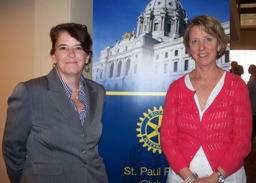JUL 10, 2012 ROTARY IN REVIEW:
Peter Heegaard
A memorial was presented by Deb Gelbach for past presient Dick Murphy. John Chandler introduced Hansi Wachtler, a recent graduate of Central High School, who will be our second Youth Exchange member this year and will be leaving shortly for Japan.
 Merry Beckman Butikis introduced a new member, Molly Boyne, from the Crowne Plaza Hotel. Merry and Molly have worked together to attract conventions to St. Paul in the past. Molly earned a Chef’s degree from St. Paul College. She started at the hotel in convention sales and is now Director of Catering. Molly is also active on the board of the St. Paul Winter Carnival.
Merry Beckman Butikis introduced a new member, Molly Boyne, from the Crowne Plaza Hotel. Merry and Molly have worked together to attract conventions to St. Paul in the past. Molly earned a Chef’s degree from St. Paul College. She started at the hotel in convention sales and is now Director of Catering. Molly is also active on the board of the St. Paul Winter Carnival.
Jim Miller introduced Peter Heegaard speaking on “How Cost Benefit Analysis can more Effectively Promote the Public Good.” A recent author of “More Bang for Your Buck,” he focuses on applying private sector return-on –investment analysis to not-for-profit organizations and public policy initiatives. His career experience is in the banking trust business with Northwestern National Bank and Lowry Hill, a subsidiary of Wells-Fargo. Following retirement, he sought to work with organizations in prioritizing scarce resources and measuring the results.
The speaker laid out his thesis early: “We are stuck in gridlock. Where can we find common ground? Where can negate the politics of fear and move to the politics of hope and mutual respect of differing opinions. How can we rally around finding the best solutions to complex problems and inspire broad public participation in the process? There needs to be a credible means of measuring what works best. Financial analytics exist in the profit and not-for-profit sector. Where are the credible means of measuring what works best in the public sector?”
For the public sector, the speaker commented on a return on investment model that is used in Europe and is gaining acceptance in the US. He explained how that might work in explaining county tax statements.
Peter then reviewed several successful instances where the analysis model had been put in place locally:
· Six major state workforce programs
· A high school program that helped students that never dreamed that they could go to college
· A neighborhood program to help neighbors start new businesses
· A food shelf program
· Six jobs skills programs
Finally, the speaker highlighted the results of Lifetrack Resource’s programs led by Rotarian Trixie Goldberg.
 In summary, he said that we have in place the ability to credibly measure programs in the public and not-for-profit sectors. We just need the will and desire to implement them. He shared one thing that he has learned from the education sector that the best investment with the best return is kindergarten through second grade programs.
In summary, he said that we have in place the ability to credibly measure programs in the public and not-for-profit sectors. We just need the will and desire to implement them. He shared one thing that he has learned from the education sector that the best investment with the best return is kindergarten through second grade programs.
President Dan adjourned the meeting at 1:30.
Jay Pfaender, Scribe

